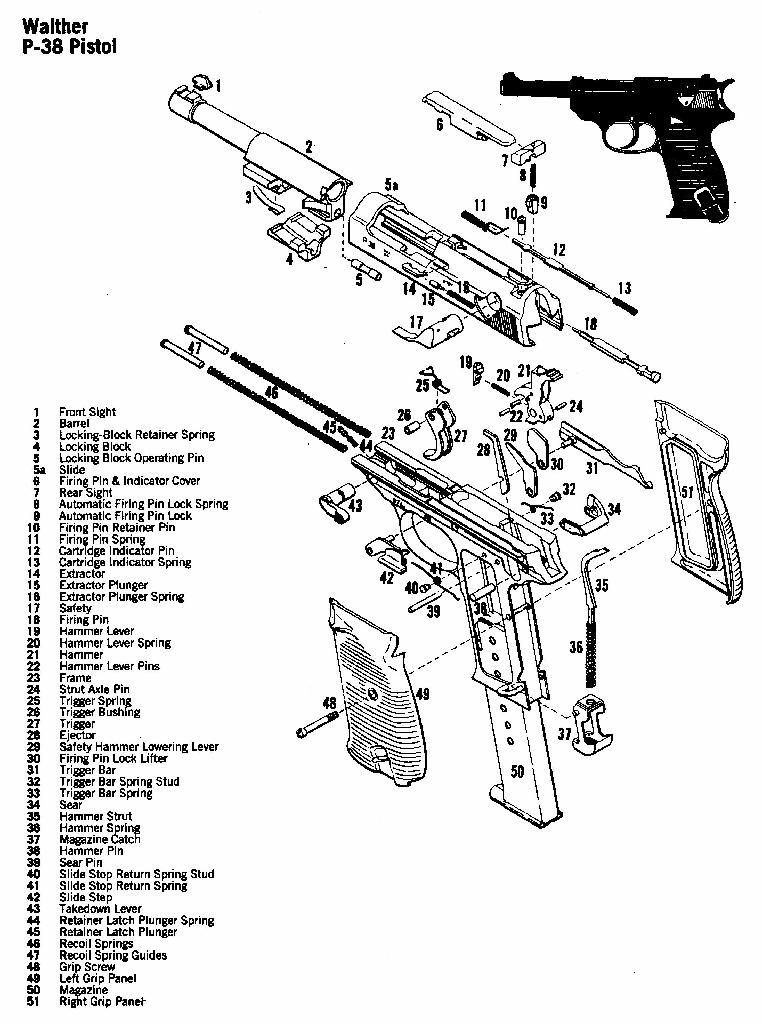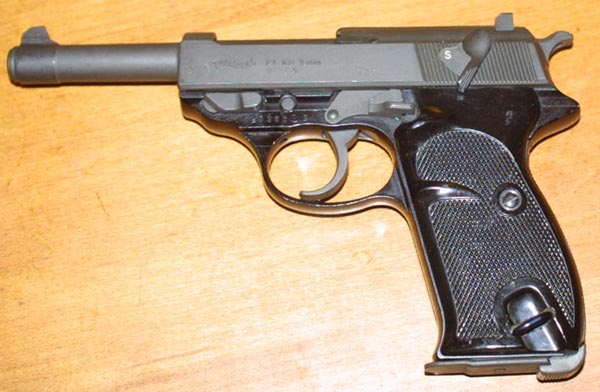 P-38 (P-1)
P-38 (P-1)
| Length | Barrel | Weight | Caliber | Action Type | Magazine Capacity |
| 8.6 | 4.9 | 2.1 | 9mm | DA Semi auto | 8 |
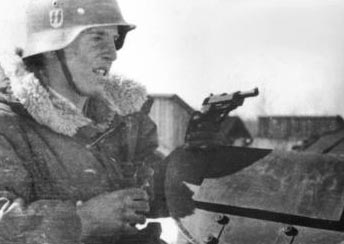 world, and Europe was recreating itself. Over all of this, hung the
specter of nuclear war, and the possibility of the destruction of world
civilization. This new world had emerged entirely because of the Second
World War, politically, geographically, technologically, and socially. Over
the dismembered corpses of the old European nations, the superpowers of
the free, and communist states glared at each other across what Winston
Churchill called an "iron curtain". In the midst of it all, the cause and
the catalyst, was Germany, and the mythology of the defeated Nazi state.
world, and Europe was recreating itself. Over all of this, hung the
specter of nuclear war, and the possibility of the destruction of world
civilization. This new world had emerged entirely because of the Second
World War, politically, geographically, technologically, and socially. Over
the dismembered corpses of the old European nations, the superpowers of
the free, and communist states glared at each other across what Winston
Churchill called an "iron curtain". In the midst of it all, the cause and
the catalyst, was Germany, and the mythology of the defeated Nazi state.
The mystique of the Nazis is with us, even today. In part this is the mantle which covers all extinct cultures and dead governments, but there is more to it than this. The nazis have been credited with an almost supernatural list of abilities, and powers. To a certain extent, this was created consciously by hitler, and his associates, with their badges, orders, and heraldry. There was a certain effort made to instill a mythology as in the days of the old knights and secret societies. This may have been, in part, an attempt to reinforce the tenuous legitimacy of their authority, though it was also certainly a reflection of their own delusions of grandeur.
Besides the vain self aggrandizement of the Nazi leaders, there was also the accomplishment of the German state. Germany did come frighteningly close to winning the war, after all, particularly in the rapidly moving initial stages of the conflict. The circumstances surrounding this near victory have been analyzed to death, over the decades, but a couple of things have become clear. The main point seems to be that the early success of the Germans was largely due to the failure in judgment and resolve, by the leaders of the democratic states. The pandering of Chamberlain, the isolationism of the U.S. Congress, and the refusal of the French to believe they were in a shooting war, along with the usual foolish efforts of the pacifists, all added to the "strength" of Germany. Unable, or unwilling, to admit their terrible error, the allies magnified Germany into a super state. The German soldiers became super solders, their planes and other tools of war became super weapons (even to the extent that, after the war, the term "wonder weapons" was applied to them), and their marshals became the last word in military genius.
At war's end, there was a curious ambivalence in the attitude of the winners. There was, at once, an admiration, and deification of all things German, while at the same time, an absolute detestation, and morbid fascination with the Nazis, who had caused the whole mess. In particular, the weapons, and technology of the Germans were held in high regard. This began with the study of German jets, missiles, submarines, and guidance systems, and extended all the way down to German small arms. This included the issue piece of the war, the P-38 pistol. So it was, that in the multitude of spy movies, TV series, books, and other cultural paraphernalia of the times, the mythological pistols of the mythological dead Reich played a prominent part, in the new mythology of the cold war, and of the spy.

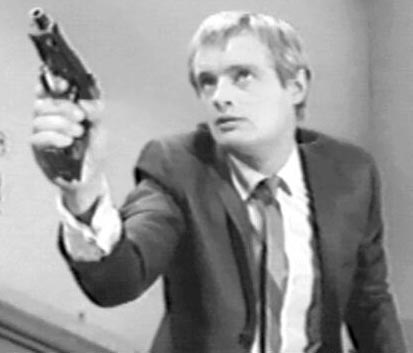 My first exposure to the P-38 was it's use in the
sixties television show, the Man From UNCLE. As a ten year old, I spent many
hours watching the tongue in cheek heroics of Napoleon and Illia. The guns
used in the series had their barrels cut down, in the manner of the P-38K,
and had some kind of odd device hanging off of the muzzle which was supposed
to be a flash hider. There was also a very awkward looking carbine version,
which would have been pretty impractical in the real world. To the legion
of young viewers, tuning in every week, these jury rigged firearms were the
last word in exotic, and deadly weapons. Though firearms experts, and gun
savvy viewers may have cringed, the rest of us were delighted. To my schoolmates
in the sixties, as well as to myself, the P-38 was the Man Form Uncle gun.
More recently, the P-38 was used by Indiana Jones, and by the Scorpio killer,
in Dirty Harry. The unique look of the gun makes it a favorite, when a certain
movie effect is desired.
My first exposure to the P-38 was it's use in the
sixties television show, the Man From UNCLE. As a ten year old, I spent many
hours watching the tongue in cheek heroics of Napoleon and Illia. The guns
used in the series had their barrels cut down, in the manner of the P-38K,
and had some kind of odd device hanging off of the muzzle which was supposed
to be a flash hider. There was also a very awkward looking carbine version,
which would have been pretty impractical in the real world. To the legion
of young viewers, tuning in every week, these jury rigged firearms were the
last word in exotic, and deadly weapons. Though firearms experts, and gun
savvy viewers may have cringed, the rest of us were delighted. To my schoolmates
in the sixties, as well as to myself, the P-38 was the Man Form Uncle gun.
More recently, the P-38 was used by Indiana Jones, and by the Scorpio killer,
in Dirty Harry. The unique look of the gun makes it a favorite, when a certain
movie effect is desired.Due to such exposure, the P-38, along with the Luger, the Colt M1911, the Colt SAA, and the ever popular Walther PPK, have became icons and legends. In addition to it's television exposure, this was a favorite war trophy with returning soldiers, and many were brought back by homebound servicemen. After the war, these guns, along with many other surplus weapons, were part of a flood of firearms which were sold cheaply to collectors, sportsmen, and gun enthusiasts by the million. I can recall, before the imposition of the GCA of 1968, seeing magazine advertisements for the P-38, the Luger, and even the old Colt M1911, for $25 - $50. It makes my heart ache to see those ads today. As with many firearms, particularly pistols, the myth is as powerful as the gun itself, and turns it into something more than a mere piece of machined metal.
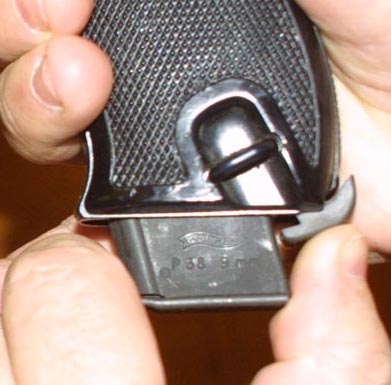 marketed to civilians as the P-38. Most noticeable was the change
from steel to alloy, in the construction of the frame. The new guns are
finely blued, and bear the Walther banner on the slide. Though a better
design, more functional, and practical than the venerable Luger, the P-38
costs half as much to produce. The P-38 has been replaced in army use, by
the newer P-88, and in police use by the P-5. The difference between the
models is largely cosmetic. The P-5 is, essentially, a P-38 with the slide
streamlined, and lengthened to cover the entire barrel. There were some changes
to the safety system; but operation of the new guns remains the same. While
the P-88, and P-99 have a more conventional Browning style locking system.
marketed to civilians as the P-38. Most noticeable was the change
from steel to alloy, in the construction of the frame. The new guns are
finely blued, and bear the Walther banner on the slide. Though a better
design, more functional, and practical than the venerable Luger, the P-38
costs half as much to produce. The P-38 has been replaced in army use, by
the newer P-88, and in police use by the P-5. The difference between the
models is largely cosmetic. The P-5 is, essentially, a P-38 with the slide
streamlined, and lengthened to cover the entire barrel. There were some changes
to the safety system; but operation of the new guns remains the same. While
the P-88, and P-99 have a more conventional Browning style locking system.